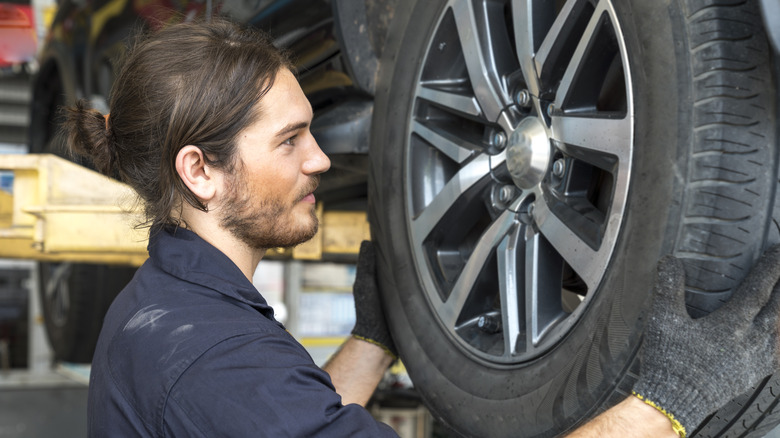How Often Should Tires Be Rotated? Here's What You Need To Know
If you want your car to last long (all without compromising performance), you need to keep up with simple automotive care routines. One of the most basic things you can do is ensure your tires are in ideal condition. After all, tires are what support your vehicle, and they usually take more of a beating. When they do, you'll likely spend hundreds of dollars on a new set. That's why engaging in regular maintenance like wheel alignment, checking tire pressure, and of course, tire rotation is crucial.
Rotating your tires is one maintenance step that often flies under the radar; it always seems like a minor job. However, to keep your tires as reliable as possible (even these durable summer tires), you'll have to rotate your tires regularly. Skipping it can lead to uneven wear and subpar tire performance. Plus, you risk reducing your car's efficiency and creating safety hazards due to compromised handling, especially in adverse weather conditions.
Unlike brake pads that come with obvious warning signs, tires wear down inconsistently and quietly. So, it's challenging to know when and how often to rotate them. When it comes to tire rotation, there's no one-size-fits-all answer on how often this should be done. The general rule of thumb is that you should rotate the tires every 3,000 to 5,000 miles. That often aligns perfectly with routine oil changes, so it should be easier to remember. Still, factors like your tire type, driving habits, and your vehicle's drivetrain all play a crucial role in determining this
When should you visit a mechanic for tire rotation (and how often)
While most experts recommend following that strict schedule, the best interval to rotate your tires will vary depending on your vehicle and driving habits. For instance, if you're a gearhead who enjoys long-distance commutes, your tires will experience more uniform wear as highway driving involves less turning and braking. In that case, stretching your rotation intervals to 8,000 miles will make sense as the uneven wear will be reduced. City drivers, on the other hand, will want to stick to the 5,000-mile mark. The tires will wear down faster due to all the braking and steering.
Aside from that, you should also check your tire type. If you're using performance tires, you'll want to rotate the tires every 3,000 miles. Of course, these tires are designed to offer superior performance and handling at higher speeds. However, that control comes at a cost; they usually wear unevenly, reducing their lifespan. Lastly, you'll want to read your car's manual. Some automakers have specific mileage intervals and rotation patterns based on the vehicle's drivetrain (FWD, RWD, or AWD).
Clear signs you need to rotate your tires
In addition to the recommended mileage intervals, there are other telltale signs that will help you know if your tires are due for rotation. When your tires have an issue, one of the first signs is often uneven tire wear. If you inspect your tires and notice that the rear ones are more worn out than the front tires — or vice versa — that's a solid clue that it's time to visit a mechanic. A simple tread-depth test can help determine this, or you can even have a mechanic inspect them during a routine inspection service.
Generally, when driving on highways, a car should feel smooth and stable, with minimal vibration at higher speeds. However, if your car starts to feel shaky or less smooth, that's a clear sign that you need to rotate the tires as soon as possible. Not only will this affect your ride quality, but it'll also negatively impact your fuel efficiency.
Another one of the most common signs that you need to rotate the tires is when it begins to pull on one side. Under normal conditions, your car's steering should remain centered, even when you take your hands off the wheel. However, if it veers to one side, and you've recently visited a mechanic for tire rotation, that could be a sign of uneven tire wear or a lousy alignment.


